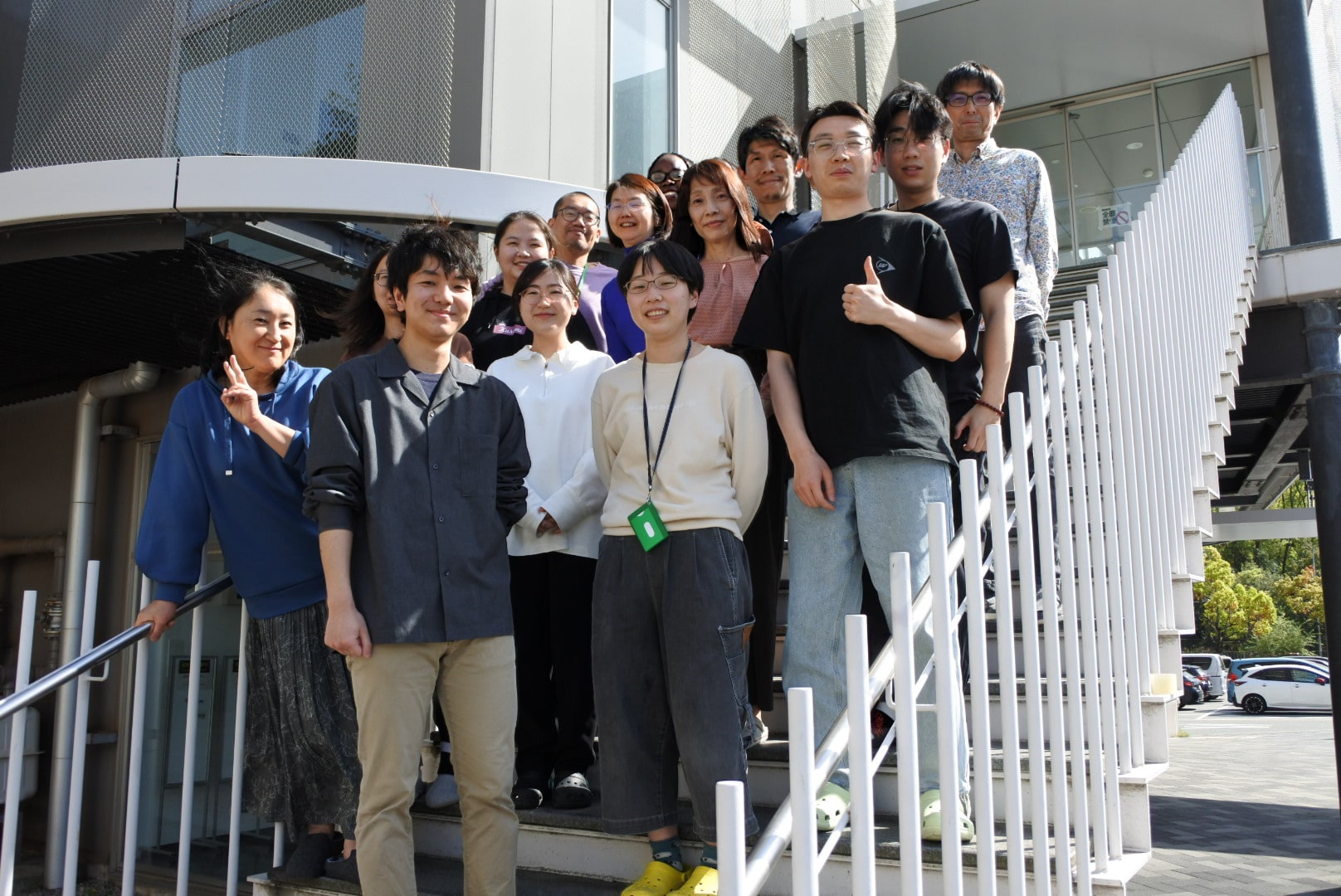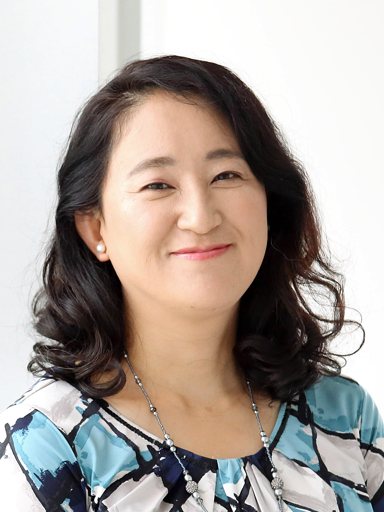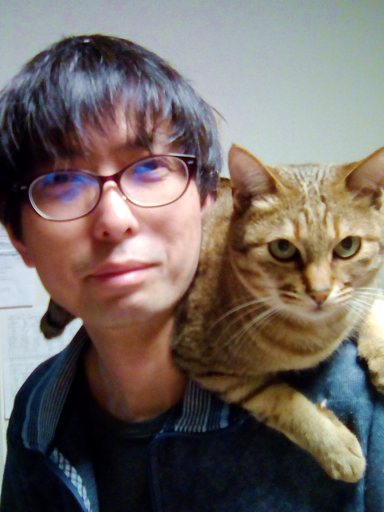Lab Members

Taken on November 21, 2025

Toshie Kai
Professor
- E-mail: kai.toshie.fbsosaka-u.ac.jp
- Osaka University Researchers
In 1998, Toshie KAI earned a Ph.D in Graduate School of Science, Department of Biological Science at Osaka University. She went on a postdoctral career in Dr. Allan Spradling‘s lab at Department of Embryology, Carnegie Institution of Washington/HHMI in USA, where she was first introduced to Drosophila melanogaster, fruit flies. Since then, she has been studying biology of germline cells using this excellent model organism. In 2005, she set up her own lab in Temasek Lifescience Laboratories (TLL), Singapore, as a Principal Investigator. In 2010, she was promoted to Senior Principal Investigator in TLL. She also served as an Adjunct Assistant Prof (2009–2010) and Associate Prof (2011–2015) in Department of Biological Science, National University of Singapore. In 2015, she moved her lab from Singapore to Osaka, at Graduate School of Frontier Bioscience, Osaka Univ.
-
Publications
Research articles
- Kai T, Zheng J, Iki T. (2025) Paralog‐Dependent Specialization of Paf1C Subunit, Ctr9, for Sex Chromosome Gene Regulation and Male Germline Differentiation in Drosophila. Genes to Cells, 30:e70040
doi: 10.1111/gtc.70040 - Kawaguchi S, Xu X, Soga T, Yamaguchi K, Kawasaki R, Shimouchi R, Date S, Kai T. (2024) In silico screening by AlphaFold2 program revealed the potential binding partners of nuage-localizing proteins and piRNA-related proteins. eLife, 13:RP101967
doi: 10.7554/eLife.101967 - Xu F, Suyama R, Inada T, Kawaguchi S, Kai T. (2024) HemK2 functions for sufficient protein synthesis and RNA stability through eRF1 methylation during Drosophila oogenesis. Development, 151(14):dev202795
doi: 10.1242/dev.202795 - Suyama R, Cetraro N, Yew J Y, Kai T. (2023) Microbes control Drosophila germline stem cell increase and egg maturation through hormonal pathways. Commun. Biol., 6:Article number: 1287
doi: 10.1038/s42003-023-05660-x - Lin Y, Suyama R, Kawaguchi S, Iki T, Kai T. (2023) Tejas functions as a core component in nuage assembly and precursor processing in Drosophila piRNA biogenesis. J. Cell Biol., 222(10):e202303125
doi: 10.1083/jcb.202303125
PubMed ID: 37555815 - Iki T, Kawaguchi S, Kai T. (2023) miRNA/siRNA-directed pathway to produce noncoding piRNAs from endogenous protein-coding regions ensures Drosophila spermatogenesis. Science Advances, 9(29)
doi: 10.1126/sciadv.adh0397 - *Lim L-X, *Isshiki W, Iki T, Kawaguchi S, Kai T. (2022) The Tudor-domain containing protein, Kotsubu (CG9925), localizes to the nuage and functions in piRNA biogenesis in D. melanogaster. Frontiers in Molecular Biosciences (section RNA Networks and Biology), 9:Article 818302
*Co-first authors
doi: 10.3389/fmolb.2022.818302 - *Iki T, Takami M, *Kai T. (2020) Modulation of Ago2 Loading by Cyclophilin 40 Endows a Unique Repertoire of Functional miRNAs during Sperm Maturation in Drosophila. Cell Reports, 33(6):108380--108393
*Co-corresponding
doi: 10.1016/j.celrep.2020.108380 - Kawaguchi S, Ueki M, Kai T. (2020) Drosophila MARF1 ensures proper oocyte maturation by regulating nanos expression. PLoS One, 15(4):e0231114
doi: 10.1371/journal.pone.0231114
PubMed ID: 32243476 - Teo RYW, Anand A, Sridhar V, Okamura K, Kai T. (2018) Heterochromatin protein 1a functions for piRNA biogenesis predominantly from pericentric and telomeric regions in Drosophila. Nat. Commun., 9:1735
doi: 10.1038/s41467-018-03908-3 - Quénerch’du E, Anand A, Kai T. (2016) The piRNA pathway is developmentally regulated during spermatogenesis in Drosophila. RNA, 22(7):1044–1054
doi: 10.1261/rna.055996.116 - Patil VS, Anand A, Chakrabarti A, Kai T. (2014) The Tudor domain protein Tapas, a homolog of the vertebrate Tdrd7, functions in piRNA pathway to regulate retrotransposons in germline of Drosophila melanogaster. BMC Biol., 12:61
doi: 10.1186/s12915-014-0061-9
PubMed ID: 25287931 - Anand A, Kai T. (2014) Response to ‘Antisense piRNA amplification, but not piRNA production or nuage assembly, requires the Tudor-domain protein Qin’ (Correspondence). EMBO J., 33(6):540–541
doi: 10.1002/embj.201387548
PubMed ID: 24652837 - Lim RSM, Anand A, Nishimiya-Fujisawa C, Kobayashi S, Kai T. (2014) Analysis of Hydra PIWI proteins and piRNAs uncover early evolutionary origins of the piRNA pathway. Dev. Biol., 386(1):237–251
doi: 10.1016/j.ydbio.2013.12.007 - Pek JW, Ng BF, Kai T. (2012) Polo-mediated phosphorylation of Maelstrom regulates oocyte determination. Development, 139(24):4505–4513
doi: 10.1242/dev.082867 - Anand A, Kai T. (2012) The tudor domain protein Kumo is required to assemble the nuage and to generate germline piRNAs in Drosophila. EMBO J., 31(4):870–882
doi: 10.1038/emboj.2011.44 - Pek JW, Kai T. (2011) DEAD-box RNA helicase Belle/DDX3 and the RNA interference pathway promote mitotic chromosome segregation. Proc. Natl. Acad. Sci. USA, 108(29):12007–12012
doi: 10.1073/pnas.1106245108 - Pek JW, Kai T. (2011) A role for Vasa in regulating mitotic chromosome condensation in Drosophila. Curr. Biol., 21(1):39–44
doi: 10.1016/j.cub.2010.11.051 - Patil VS, Kai T. (2010) Repression of retroelements in Drosophila germline via piRNA pathway by the tudor domain protein Tejas. Curr. Biol., 20(8):724–730
doi: 10.1016/j.cub.2010.02.046 - Pek JW, Lim AK, Kai T. (2009) Drosophila Maelstrom Ensures Proper Germline Stem Cell Lineage Differentiation by Repressing microRNA-7. Dev. Cell, 17(3):417–424
doi: 10.1016/j.devcel.2009.07.017 - Lim AK, Tao L, Kai T. (2009) piRNAs mediate post-transcriptional retroelement silencing and localization to pi-bodies in the Drosophila germline. J. Cell Biol., 186(3):333–342
doi: 10.1083/jcb.200904063 - Lim AK, Kai T. (2007) Unique germ-line organelle, nuage, functions to repress selfish genetic elements in Drosophila melanogaster. Proc. Natl. Acad. Sci. USA, 104(16):6714–6719
doi: 10.1073/pnas.0701920104 - Kai T, Williams D, Spradling AC. (2005) The expression profile of purified Drosophila germline stem cells. Dev. Biol., 283(2):486–502
doi: 10.1016/j.ydbio.2005.04.018 - Kai T, Spradling A. (2004) Differentiating germ cells can revert into functional stem cells in Drosophila melanogaster ovaries. Nature, 428(6982):564–569
doi: 10.1038/nature02436 - Kai T, Spradling A. (2003) An empty Drosophila stem cell niche reactivates the proliferation of ectopic cells. Proc. Natl. Acad. Sci. USA, 100(8):4633–4638
doi: 10.1073/pnas.0830856100
Review articles
- Kawaguchi S, Isshiki W, Kai T. (2025) Factories without walls: The molecular architecture and functions of non-membrane organelles in small RNA-guided genome protection. Biochimica et biophysica acta. General subjects, 1869(7):130811–130811
doi: 10.1016/j.bbagen.2025.130811 - Suyama R, Kai T. (2024) piRNA processing within non-membrane structures is governed by constituent proteins and their functional motifs. FEBS J.,
doi: 10.1111/febs.17360 - Arakawa K, Hirose T, Inada T, Ito T, Kai T, Oyama M, Tomari Y, Yoda T, Nakagawa S. (2023) Nondomain biopolymers: Flexible molecular strategies to acquire biological functions. Genes to Cells,
doi: 10.1111/gtc.13050
PubMed ID: 37249032 - Niwa R, Kai T. (2020) Editorial overview: Stem cells orchestrate oogenesis: a lesson from the fruit fly, Drosophila melanogaster. Curr. Opin. Insect Sci., 37:iii–v
doi: 10.1016/j.cois.2020.03.001 - Gleason RJ, Anand A, *Kai T, *Chen X. (2017) Protecting and diversifying the germline. GENETICS, 208(2):435–471
(A part of FLY BOOK) *Co-corresponding
doi: 10.1534/genetics.117.300208 - Lim RSM, Kai T. (2015) A piece of the pi(e): the diverse roles of animal piRNAs and their PIWI partners. Sem. Cell Dev. Biol., 47–48:17–31
(Special Issue on Coding and Non-coding RNAs)
doi: 10.1016/j.semcdb.2015.10.025 - Pek JW, Anand A, Kai T. (2012) Tudor domain proteins in development (Invited Review Article). Development, 139:2255–2266
doi: 10.1242/dev.073304 - Pek JW, Patil VS, Kai T. (2012) The piRNA pathway and the potential processing site, the nuage, in the Drosophila germline. Dev. Growth Differ., 54(1):66–77
doi: 10.1111/j.1440-169X.2011.01316 - Pek JW, Kai T. (2011) Non-coding RNAs enter mitosis: functions, conservation and implications. Cell Div., 6:6
doi: 10.1186/1747-1028-6-6
PubMed ID: 21356070 - Pek JW, Kai T. (2009) Conserved germline organelle, nuage, serves as site for processing of Piwi-interacting RNAs. (in Japanese). Exp. Med., 27:393–399
- Kai T. (2004) Germline stem cells and their niches. (in Japanese). Tanpakushitsu Kakusan Koso, 49(6):710–717
- Spradling A, Drummond-Barbosa D, Kai T. (2001) Stem cells find their niche. Nature, 414(6859):98–104
doi: 10.1038/35102160
Protocol articles
- Lim RS, Osato M, Kai T. (2015) Isolation of undifferentiated female germline cells from adult Drosophila ovaries. Curr. Protoc. Stem Cell Biol., 34:2E.3.1–2E.3.14
doi: 10.1002/9780470151808.sc02e03s22
- Kai T, Zheng J, Iki T. (2025) Paralog‐Dependent Specialization of Paf1C Subunit, Ctr9, for Sex Chromosome Gene Regulation and Male Germline Differentiation in Drosophila. Genes to Cells, 30:e70040

Taichiro Iki
Associate Professor
In 2008, I earned my Ph.D in Dr. Hiroshi Oyaizu’s lab in the graduate school of the university of Tokyo. My research focus was on one of symbiotic bacteria, Azorhizobium caulinodans, which induces nodules on a leguminous plant Sesbania rostrata. In the symbiotic organ, A. caulinodans converts atmospheric N2 to ammonium to serve it to the host plants. I was studying of the nif gene clusters essential for N2 fixation, especially of the regulatory mechanisms on their expression.
From 2008 to 2012, I was working as a postdoc in Dr. Masayuki Ishikawa’s lab in the National Institute of Agrobiological Sciences (NIAS). One of my research objectives was to elucidate the molecular mechanisms by which small non-coding RNAs repress target gene expression in plants. We have developed a cell-free system that recapitulates the assembly and activity of RNA-induced silencing complex (RISC), the effector of posttranscriptional gene silencing. The findings include the dependence of RISC assembly on molecular chaperone machinery comprising HSP90 and the co-chaperone cyclophilin 40/SQUINT.
From 2012 to 2016, I was working as a postdoc in Dr. Olivier Voinnet’s lab in ETH Zürich, and experienced the European academic cultures. During the period of 2013 to 2015, my research was funded by Marie Curie International Incoming Fellowships. The research topics include the dissection of viral suppressors of RNA silencing which have been developed by diverse viral genera as a counter defensive strategy against host antiviral RNA silencing activities. Also, I was studying of microRNA (miRNA) structures and the cellular impacts.
From February in 2016, I am working as an assistant professor in Dr. Toshie Kai’s lab at Graduate School of Frontier Bioscience (FBS), Osaka University. Our research objective is to decipher the mechanisms underlying the maintenance and differentiation of germ cells in animals. We are using a model organism Drosophila melanogaster. Of my particular interest, if not all, are the non-coding RNA-mediated processes in oogenesis or spermatogenesis.
-
Publications
Research articles
- Kai T, Zheng J, Iki T. (2025) Paralog‐Dependent Specialization of Paf1C Subunit, Ctr9, for Sex Chromosome Gene Regulation and Male Germline Differentiation in Drosophila. Genes to Cells, 30:e70040
doi: 10.1111/gtc.70040 - Lin Y, Suyama R, Kawaguchi S, Iki T, Kai T. (2023) Tejas functions as a core component in nuage assembly and precursor processing in Drosophila piRNA biogenesis. J. Cell Biol., 222(10):e202303125
doi: 10.1083/jcb.202303125
PubMed ID: 37555815 - Iki T, Kawaguchi S, Kai T. (2023) miRNA/siRNA-directed pathway to produce noncoding piRNAs from endogenous protein-coding regions ensures Drosophila spermatogenesis. Science Advances, 9(29)
doi: 10.1126/sciadv.adh0397 - *Iki T, Takami M, *Kai T. (2020) Modulation of Ago2 Loading by Cyclophilin 40 Endows a Unique Repertoire of Functional miRNAs during Sperm Maturation in Drosophila. Cell Reports, 33(6):108380–108393
*Co-corresponding - Iki T, Tschopp MA, Voinnet O. (2017) Biochemical and genetic functional dissection of the P38 viral suppressor of RNA silencing. RNA, 23(5):639–654
- Yoshikawa M, Iki T, Tsutsui Y, Miyashita K, Poethig S, Habu Y, Ishikawa M. (2013) 3’ fragment of miR173-programmed RISC-cleaved RNA is protected from degradation in a complex with RISC and SGS3. Proc. Nat. Acad. Sci. USA, 110(10):4117–4122
- Ye R, Wang W, Iki T, Liu C, Wu Y, Ishikawa M, Zhou X, Qi Y. (2012) Cytoplasmic Assembly and Selective Nuclear Import of Arabidopsis ARGONAUTE4/siRNA Complexes. Mol. Cell, 46(6):859–870
- Iki T, Yoshikawa M, Meshi T, Ishikawa M. (2012) Cyclophilin 40 facilitates HSP90-mediated RISC assembly in plants. EMBO J., 31(2):267–278
- Iki T, Yoshikawa M, Nishikiori M, Jaudal MC, Matsumoto-Yokoyama E, Mitsuhara I, Meshi T, Ishikawa M. (2010) In vitro assembly of plant RNA-induced silencing complexes facilitated by molecular chaperone HSP90. Mol. Cell, 39(2):282–291
- Suzuki T, Aono T, Liu C. T, Suzuki S, Iki T, Yokota K, Oyaizu H. (2008) An outer membrane autotransporter, AoaA, of Azorhizobium caulinodans is required for sustaining high N2-fixing activity of stem nodules. FEMS Microbiology Letters, 285:16–24
- Suzuki, S, Aono T, Lee KB, Suzuki T, Liu C. T, Miwa H, Wakao S, Iki T, Oyaizu H. (2007) Rhizobial factors required for stem nodule maturation and maintenance in Sesbania rostrata-Azorhizobium caulinodans ORS571 symbiosis. Applied and Environmental Microbiology, 73:6650–6659
- Iki T, Aono T, Oyaizu H. (2007) Evidence for functional differentiation of duplicated nifH genes in Azorhizobium caulinodans. , 274(2):173–179
- Liu, CT, Aono T, Kinoshita M, Miwa H, Iki T, Lee KB, Oyaizu H. (2006) Isolation and differential expression of beta-1,3-glucanase messenger RNAs, SrGLU3 and SrGLU4, following inoculation of Sesbania rostrata. Functional Plant Biology, 33:983–990
Review articles
- Iki T. (2017) Messages on small RNA duplexes in plants. J. Plant Res., 130:7–16
- Kai T, Zheng J, Iki T. (2025) Paralog‐Dependent Specialization of Paf1C Subunit, Ctr9, for Sex Chromosome Gene Regulation and Male Germline Differentiation in Drosophila. Genes to Cells, 30:e70040

Shinichi Kawaguchi
Assistant Professor
In 1998, I earned a Ph.D in Graduate School of Science, Department of Biological Science at Osaka University. From 1999 to 2001, I was working as a postdoc in Dr. Shigeyuki Yokoyama‘s lab (Spring-8, RIKEN) to elucidate the protein function from its 3D structure. In 2001, I joined Dr. Yixian Zheng‘s lab as a research fellow to study the mechanism by which the microtubules are tethered to the centrosome. In 2004, I was working in NEC Soft Ltd for the collaboration with Meiji-Pharmaceutical University. From 2005 to 2014, I was working as a postdoc in Dr. Davis Ng‘s lab (Temasek Lifesciences Laboratory, Singapore) to study the mechanism of the protein quality control. I am working as an assistant professor in Dr. Toshie Kai’s lab at Graduate School of Frontier Bioscience (FBS), Osaka University to study the protein function which is essential for the germline development.
-
Publications
Research articles
- Kawaguchi S, Xu X, Soga T, Yamaguchi K, Kawasaki R, Shimouchi R, Date S, Kai T. (2024) In silico screening by AlphaFold2 program revealed the potential binding partners of nuage-localizing proteins and piRNA-related proteins. eLife, 13:RP101967
doi: 10.7554/eLife.101967 - Xu F, Suyama R, Inada T, Kawaguchi S, Kai T. (2024) HemK2 functions for sufficient protein synthesis and RNA stability through eRF1 methylation during Drosophila oogenesis. Development, 151(14):dev202795
doi: 10.1242/dev.202795 - Lin Y, Suyama R, Kawaguchi S, Iki T, Kai T. (2023) Tejas functions as a core component in nuage assembly and precursor processing in Drosophila piRNA biogenesis. J. Cell Biol., 222(10):e202303125
doi: 10.1083/jcb.202303125
PubMed ID: 37555815 - Iki T, Kawaguchi S, Kai T. (2023) miRNA/siRNA-directed pathway to produce noncoding piRNAs from endogenous protein-coding regions ensures Drosophila spermatogenesis. Science Advances, 9(29)
doi: 10.1126/sciadv.adh0397 - Kawaguchi S, Ueki M, Kai T. (2020) Drosophila MARF1 ensures proper oocyte maturation by regulating nanos expression. PLoS One, 15(4):e0231114
- Kanamori E, Kawaguchi S, Kuramitsu S, Kouyama T, Murakami M. (2015) Structural comparison between the open and closed forms of citrate synthase from Thermus thermophilus HB8. Biophys. Physicobiol., 12:47–56
doi: 10.2142/biophysico.12.0_47
PubMed ID: 27493854 - Prasad R, Kawaguchi S, Ng DT. (2012) Biosynthetic mode can determine the mechanism of protein quality control. Biochem. Biophys. Res. Commun., 425(3):689–695
- Kawaguchi S, Hsu CL, Ng DT. (2010) Interplay of substrate retention and export signals in endoplasmic reticulum quality control. PLoS One, 5(11):e15532
- Prasad R, Kawaguchi S, Ng DT. (2010) A nucleus-based quality control mechanism for cytosolic proteins. Mol. Biol. Cell, 21(13):2117–2127
- Ducat D, Kawaguchi S, Liu H, Yates JR 3rd, Zheng Y. (2008) Regulation of microtubule assembly and organization in mitosis by the AAA+ ATPase Pontin. Mol. Biol. Cell, 19(7):3097–3110
- Ito K, Arai R, Fusatomi E, Kamo-Uchikubo T, Kawaguchi S, Akasaka R, Terada T, Kuramitsu S, Shirouzu M, Yokoyama S. (2006) Crystal structure of the conserved protein TTHA0727 from Thermus thermophilus HB8 at 1.9 Å resolution: A CMD family member distinct from carboxymuconolactone decarboxylase (CMD) and AhpD. Protein Sci., 15(5):1187–1192
doi: 10.1110/ps.062148506
PubMed ID: 16597838 - Tanaka Y, Tawaramoto-Sasanuma M, Kawaguchi S, Ohta T, Yoda K, Kurumizaka H, Yokoyama S. (2004) Expression and purification of recombinant human histones. Methods, 33(1):3–11
- Kawaguchi S, Zheng Y. (2004) Characterization of a Drosophila centrosome protein CP309 that shares homology with Kendrin and CG-NAP. Mol. Biol. Cell, 15(1):37–45
- Tanaka Y, Nureki O, Kurumizaka H, Fukai S, Kawaguchi S, Ikuta M, Iwahara J, Okazaki T, Yokoyama S. (2001) Crystal structure of the CENP-B protein-DNA complex: the DNA-binding domains of CENP-B induce kinks in the CENP-B box DNA. EMBO J., 20(23):6612–6618
- Ura H, Nakai T, Kawaguchi S, Miyahara I, Hirotsu K, Kuramitsu S. (2001) Substrate recognition mechanism of thermophilic dual-substrate enzyme. J. Biochem. (Tokyo), 130(1):89–98
- Kawaguchi S, Muller J, Linde D, Kuramitsu S, Shibata T, Inoue Y, Vassylyev DG, Yokoyama S. (2001) The crystal structure of the ttCsaA protein: an export-related chaperone from Thermus thermophilus. EMBO J., 20(3):562–569
- Renault L, Kerjan P, Pasqualato S, Menetrey J, Robinson JC, Kawaguchi S, Vassylyev DG, Yokoyama S, Mirande M, Cherfils J. (2001) Structure of the EMAPII domain of human aminoacyl-tRNA synthetase complex reveals evolutionary dimer mimicry. EMBO J., 20(3):570–578
- Ishijima J, Nakai T, Kawaguchi S, Hirotsu K, Kuramitsu S. (2000) Free energy requirement for domain movement of an enzyme. J. Biol. Chem., 275(25):18939–18945
- Matsui I, Matsui E, Sakai Y, Kikuchi H, Kawarabayasi Y, Ura H, Kawaguchi S, Kuramitsu S, Harata K. (2000) The molecular structure of hyperthermostable aromatic aminotransferase with novel substrate specificity from Pyrococcus horikoshii. J. Biol. Chem., 275(7):4871–4879
- Nakai T, Okada K, Akutsu S, Miyahara I, Kawaguchi S, Kato R, Kuramitsu S, Hirotsu K. (1999) Structure of Thermus thermophilus HB8 aspartate aminotransferase and its complex with maleate. Biochemistry, 38(8):2413–2424
- Nobe Y, Kawaguchi S, Ura H, Nakai T, Hirotsu K, Kato R, Kuramitsu S. (1998) The novel substrate recognition mechanism utilized by aspartate aminotransferase of the extreme thermophile Thermus thermophilus HB8. J. Biol. Chem., 273(45):29554–29564
- Kawaguchi S, Kuramitsu S. (1998) Thermodynamics and molecular simulation analysis of hydrophobic substrate recognition by aminotransferases. J. Biol. Chem., 273(29):18353–18364
- Nakai T, Okada K, Kawaguchi S, Kato R, Kuramitsu S, Hirotsu K. (1998) Crystallization and preliminary X-ray characterization of aspartate aminotransferase from an extreme thermophile, Thermus thermophilus HB8. Acta Cryst., D54(Pt 5):1032–1034
- Hiramatsu Y, Kato R, Kawaguchi S, Kuramitsu S. (1997) Cloning and characterization of the uvrD gene from an extremely thermophilic bacterium, Thermus thermophilus HB8. Gene, 199:77–82
- Kawaguchi S, Nobe Y, Yasuoka J, Wakamiya T, Kusumoto S, Kuramitsu S. (1997) Enzyme flexibility: new concept in recognition of hydrophobic substrates. J. Biochem., 122(1):55–63
- Kawaguchi S, Kuramitsu S. (1995) Separation of heat-stable proteins from Thermus thermophilus HB8 by two-dimensional electrophoresis. Electophoresis, 16:1060–1066
- Kawaguchi S, Kuramitsu S. (1994) Homologus ligation. Trends Genet., 10(12):420
- Miyazawa K, Kawaguchi S, Okamoto A, Kato R, Ogawa T, Kuramitsu S. (1994) Construction of aminotransferase chimeras and analysis of their substrate specificity. J. Biochem., 115(3):568–577
Review articles
- Kawaguchi S, Isshiki W, Kai T. (2025) Factories without walls: The molecular architecture and functions of non-membrane organelles in small RNA-guided genome protection. Biochimica et biophysica acta. General subjects, 1869(7):130811–130811
doi: 10.1016/j.bbagen.2025.130811 - Kawaguchi S, Ng DT. (2007) SnapShot: ER-associated protein degradation pathways. Cell, 129(6):1230
- Kanehara K, Kawaguchi S, Ng DT. (2007) The EDEM and Yos9p families of lectin-like ERAD factors. Semin Cell Dev. Biol., 18(6):743–750
- Yokoyama S, Matsuo Y, Hirota H, Kigawa T, Shirouzu M, Kuroda Y, Kurumizaka H, Kawaguchi S, Ito Y, Shibata T, Kainosho M, Nishimura Y, Inoue Y, Kuramitsu S. (2000) Structural genomics projects in Japan. Prog. Biophys. Mol. Biol., 73(5):363–376
- Kawaguchi S, Kuramitsu S. (1994) Mechanism of enzyme reaction. (in Japanese). Tanpakushitsu Kakusan Koso, 39(7):1083–1090
- Kawaguchi S, Xu X, Soga T, Yamaguchi K, Kawasaki R, Shimouchi R, Date S, Kai T. (2024) In silico screening by AlphaFold2 program revealed the potential binding partners of nuage-localizing proteins and piRNA-related proteins. eLife, 13:RP101967
Hilo YEN
Research Fellow
Masaya Matsui
PhD Student D5/D5
Xin XU
PhD Student D5/D5 (Support for Pioneering Research Initiated by the Next Generation [SPRING])
Wakana Isshiki
PhD Student D5/D5 (Major in FBS, Minor in WISE / JSPS DC1)
Hinano Minami
PhD Student D3/D5 (Support for Pioneering Research Initiated by the Next Generation [SPRING])
Haitian QIN
PhD Student D3/D5
Naoki Murakami
PhD Student D2/D5
Jinglan ZHENG
PhD Student D1/D5
Daisuke Kurita
PhD Student D1/D5
Chisato Yanagisawa
Technical Assistant
Minako Moriguchi
Technical Assistant
Koutaro Taniguchi
Technical Assistant